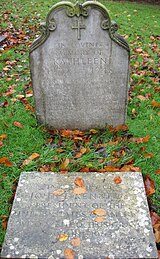Edensor: Difference between revisions
m Replacing 768739_ee826b35-by-Alan-Heardman.jpg with File:Edensor_-_Village_Scene.jpg (by Steinsplitter because: File renamed:). |
sounds like |
||
| Line 18: | Line 18: | ||
|os_grid_reference = SK251700 |
|os_grid_reference = SK251700 |
||
}} |
}} |
||
'''Edensor''' (pronounced {{IPAc-en|'|E|n|z|@r}}) is a village in [[Derbyshire]], [[England]]. It is the closest village to [[Chatsworth House]] and much of it belongs to the [[Dukes of Devonshire]]. |
'''Edensor''' (pronounced {{IPAc-en|audio=Edensor.ogg|'|E|n|z|@r}}) is a village in [[Derbyshire]], [[England]]. It is the closest village to [[Chatsworth House]] and much of it belongs to the [[Dukes of Devonshire]]. |
||
==Location== |
==Location== |
||
Revision as of 15:11, 28 February 2015
| Edensor | |
|---|---|
 Edensor | |
| OS grid reference | SK251700 |
| District | |
| Shire county | |
| Region | |
| Country | England |
| Sovereign state | United Kingdom |
| Post town | BAKEWELL |
| Postcode district | DE45 |
| Police | Derbyshire |
| Fire | Derbyshire |
| Ambulance | East Midlands |
Edensor (pronounced /ˈɛnzər/ ) is a village in Derbyshire, England. It is the closest village to Chatsworth House and much of it belongs to the Dukes of Devonshire.
Location
Originally the village was close to the River Derwent immediately below Chatsworth, but between 1838 and 1842 William Cavendish, 6th Duke of Devonshire had it moved out of sight[1] over a hill, apart from one cottage whose tenant did not want to move, which still stands in Chatsworth Park. The planning of the new village was overseen by Joseph Paxton (later Sir Joseph Paxton); in 1840 he was joined in designing houses by John Robertson.
The Chatsworth Estate office occupies a "fine brick building"[1] which was built as an inn for visitors to Chatsworth in the 18th century and attributed to James Paine. Many of the buildings in the village are listed buildings,[2] a few at the higher Grade II*, and the church at Grade I.
St Peter's church and churchyard
Church
Edensor's parish church of St Peter's was expanded by Sir George Gilbert Scott for the 7th Duke of Devonshire in the 1860s. It contains a magnificent early-17th-century memorial to Bess of Hardwick's sons, Henry and William Cavendish.
Churchyard
Joseph Paxton is buried in the St Peter's churchyard,[1] as are most Dukes of Devonshire and their families, including U.S. President John F. Kennedy's sister Kathleen Kennedy, who was married to the 10th Duke's eldest son. Kennedy visited the grave during his presidency.
The churchyard also contains three Commonwealth service war graves of World War I: a British soldier, a British sailor and a Canadian Army officer.[3]
Dunsa
The hamlet of Dunsa lies to the northwest of Edensor at grid reference SK245704.
Gallery
See also
References
- ^ a b c Pevsner, Nikolaus (1978). The Buildings of England: Derbyshire. revised Elizabeth Williamson. New Haven & London: Yale University Press. pp. 205–207. ISBN 0-14-071008-6.
- ^ "Listed Buildings in Edensor, Derbyshire, England". britishlistedbuildings.co.uk. Retrieved 7 October 2013.
- ^ "Cemetery detail: Edensor (St Peter) Churchyard". Commonwealth War Graves Commission. Retrieved 7 October 2013. Breakdown obtained from casualty record.


